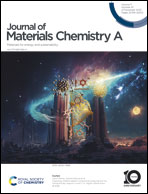Efficient heterojunction constructed from wide-bandgap and narrow-bandgap small molecules enables dual-band absorption transparent photovoltaics†
Abstract
The main challenge in transparent photovoltaics (TPV) is to balance the competition between light absorption for photocurrent and light transmittance for device transparency. Herein, we used a dual-band light absorption strategy to enhance the photocurrent of TPVs while maintaining the high transparency. TPD-2TPA with a 2.48 eV bandgap and Y6 exhibit efficient selective absorption in the ultraviolet and near-infrared regions, respectively, which is ideally complementary to the human eye photopic response spectrum. The opaque device based on efficient TPD-2TPA:Y6 bulk-heterojunction exhibits a power conversion efficiency (PCE) of up to 7.34% with a short-circuit current density (JSC) of 18.7 mA cm−2. The TPV device with an AVT of over 70% can achieve a champion PCE of 3.31% without optical modulation. The dual-band absorption TPV device shows a photocurrent of 8.03 mA cm−2, which is superior to that of the NIR-absorption device. The flexible TPV device constructed at room temperature also further verifies its potential application in the field of flexible optoelectronics.



 Please wait while we load your content...
Please wait while we load your content...